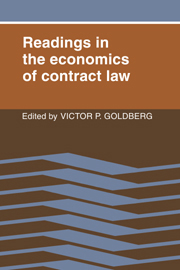Book contents
- Frontmatter
- Contents
- Preface
- Readings in the economics of contract law
- Part I Some preliminaries
- Part II Contract law and the least cost avoider
- 2.1 Unity in tort, contract, and property: the model of precaution
- 2.2 The mitigation principle: toward a general theory of contractual obligation (1)
- 2.3 Relational exchange, contract law, and the Boomer problem (1)
- Questions and notes on the least cost avoider
- Part III The expectation interest, the reliance interest, and consequential damages
- Part IV The lost-volume seller puzzle
- Part V Specific performance and the cost of completion
- Part VI Power, governance, and the penalty clause puzzle
- Part VII Standard forms and warranties
- Part VIII Duress, preexisting duty, and good faith modification
- Part IX Impossibility, related doctrines, and price adjustment
- Questions and notes on impossibility and price adjustment
- References
- Index of cases
- Author index
- Subject index
2.1 - Unity in tort, contract, and property: the model of precaution
Published online by Cambridge University Press: 10 November 2010
- Frontmatter
- Contents
- Preface
- Readings in the economics of contract law
- Part I Some preliminaries
- Part II Contract law and the least cost avoider
- 2.1 Unity in tort, contract, and property: the model of precaution
- 2.2 The mitigation principle: toward a general theory of contractual obligation (1)
- 2.3 Relational exchange, contract law, and the Boomer problem (1)
- Questions and notes on the least cost avoider
- Part III The expectation interest, the reliance interest, and consequential damages
- Part IV The lost-volume seller puzzle
- Part V Specific performance and the cost of completion
- Part VI Power, governance, and the penalty clause puzzle
- Part VII Standard forms and warranties
- Part VIII Duress, preexisting duty, and good faith modification
- Part IX Impossibility, related doctrines, and price adjustment
- Questions and notes on impossibility and price adjustment
- References
- Index of cases
- Author index
- Subject index
Summary
Forms of precaution
Even when necessary or unavoidable, an accident, breach of contract, taking, or nuisance causes harm. The affected parties, however, can usually take steps to reduce the probability or magnitude of the harm. The parties to a tortious accident can take precautions to reduce the frequency or destructiveness of accidents. In contract, the promisor can take steps to avoid breach, and the promisee, by placing less reliance on the promise, can reduce the harm caused by the promisor's breach. Similarly, for governmental takings of private property, the condemnor can conserve on its need for private property, while property owners can reduce the harm they suffer by avoiding improvements whose value would be destroyed by the taking. Finally, the party responsible for a nuisance can abate; furthermore, the victim can reduce his exposure to harm by avoiding the nuisance.
Generalizing these behaviors, I extend the ordinary meaning of the word “precaution” and use it as a term of art … to refer to any action that reduces harm. Thus the term “precaution” includes, for example, prevention of breach and reduced reliance on promises, conservation of the public need for private property and limited improvement of private property exposed to the risk of a taking, and abatement and avoidance of nuisances. These examples are, of course, illustrative, not exhaustive.
The paradox of compensation
When each individual bears the full benefits and costs of his precaution, economists say that social value is internalized. When an individual bears part of the benefits or part of the costs of his precaution, economists say that some social value is externalized.
- Type
- Chapter
- Information
- Readings in the Economics of Contract Law , pp. 53 - 60Publisher: Cambridge University PressPrint publication year: 1982
- 1
- Cited by



